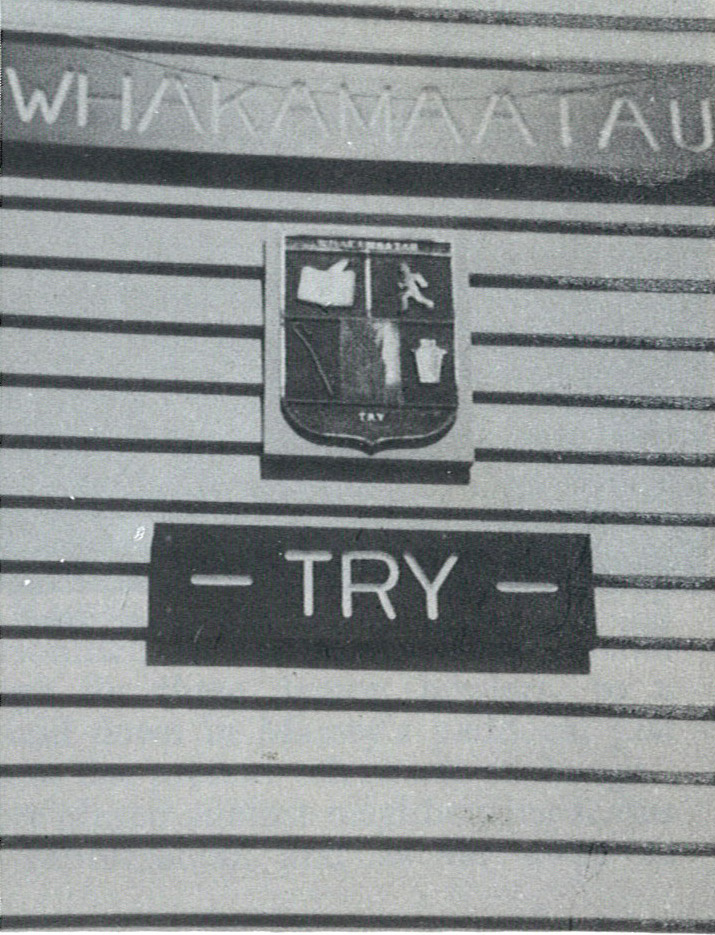School Buildings
The Waikato Times of the 11th August 1883 advertised a meeting of all interested in a School at Tauwhare.
When the sub-division plan for the proposed township of Tauwhare was drawn in 1879, a school reserve of just over two and a half acres was marked on Block I Lot 7 bounded by Elm Street, Main Road and Acacia Road. Later the whole of Block I, of just over four and a half acres was a free gift from the Waikato Land Association. The Architectural Division of the Hamilton Education Board still has the plans and specifications for the school buildings.
Tenders were called in April 1884. The specifications were explicit - puriri foundation blocks, first class kauri for interior timber and heart kauri for exterior, split heart kauri shingles on the roof, brick chimney, a kauri gate, puriri fence posts and seven wires on the fence. A 400 gallon water tank was to be provided and two handbasins in the porch with slop buckets underneath. Boot scrapers were to be set at each door, yellow linen blinds at the windows, and two single 'closets' were to be built outside. The Education Board must have provided the paint. The sashes, finials, gate and gate posts were to be white, exterior shade 11, architraves and facings shade 15, and mouldings shade 20. Interior timber was to be varnished. The School had one room 20 feet by 30 feet (approximately 6.1 by 9.1 metres) with an open fireplace, and a porch with two doors. It was built by William Goodman Bunting, builder of Mt. Eden, Auckland at a cost of $659.00 and was used for 52 years. ln.1908 the roof shingles were replaced with corrugated iron by J. C. Spindley, plumber of Devonport, Auckland for $94.00.
The room was inadequate by 1911 when an assistant teacher was appointed. From then until 1937 the two teachers worked under great difficulties. A heavy green curtain was hung to divide the room into two, and by 1928 a light partition was built part way to the ceiling. This prevented the two classes from seeing each other but could not prevent noise penetration. Miss I. J. Phillips, who was assistant teacher throughout the 1930's, had to take her juniors outside for oral lessons whenever the weather was suitable.
The School should have celebrated its 50th jubilee in 1934, but this was deferred in the hope that a new school would be built in the near future. This hope came to fruition in April 1937 when a new two roomed school and a teacher's residence were completed. Speight Pearce Nicholl Davys Ltd., of Cambridge were the builders. This time the foundation blocks were to be concrete, plates and studs of heart totara, interior of heart rimu, exterior of heart matai and the roof of corrugated iron. New 'outbuildings' were to be provided and a 15 foot (4.6 metre) kauri flagpole. There were two classrooms 21 feet 6 inches (6.4 metres) wide. Number 1 was 20 feet (6.1 metres) long and Number 2 was 17 feet (5.1 metres). A corridor 7 feet (2.1 metres) wide ran along the back and the western end was enclosed to make a small staffroom. Handbasins were provided in the corridor. The weather boards were painted board stone, sashes and architraves white, doors and base, seats and spouting permanent green, and the roof red oxide. Inside, the tongue and groove dado was varnished with the walls above painted pastel colours and the ceilings white.

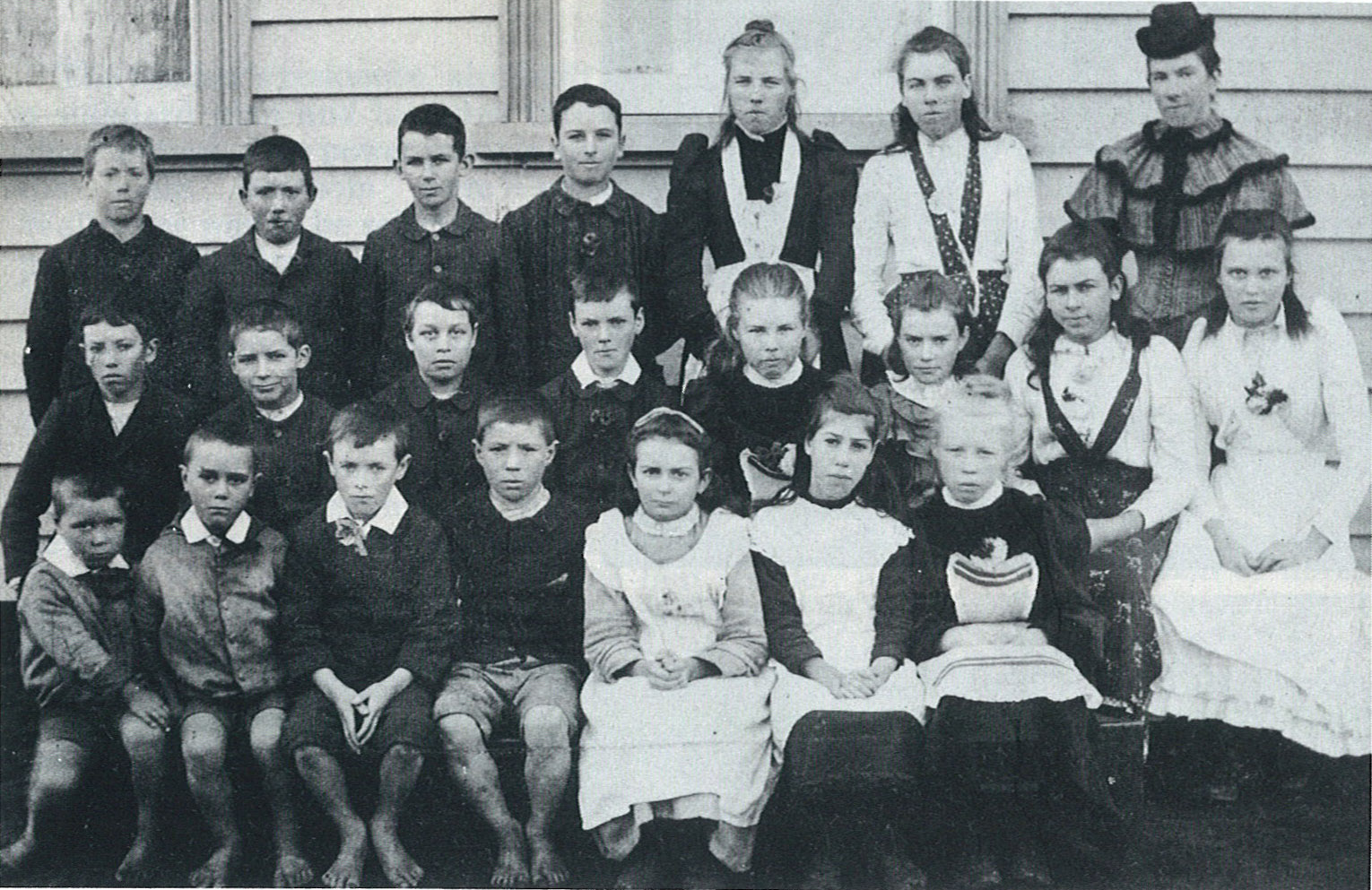
Teacher Miss E. Biggs, Charles Shaw (2nd from left back row), Ellen Tickelpenny (later Mrs David Shaw, 5th, back row).
Left: Jubilee Opening of New School 1937. Rev. C. W. Clark, first teacher in centre. First day pupils W. Richardson (3rd from left), T. Shaw (4th), Lizzie Shaw (nee Richardson 4th from right), Margaret Ferns (nee Richardson 3rd right).

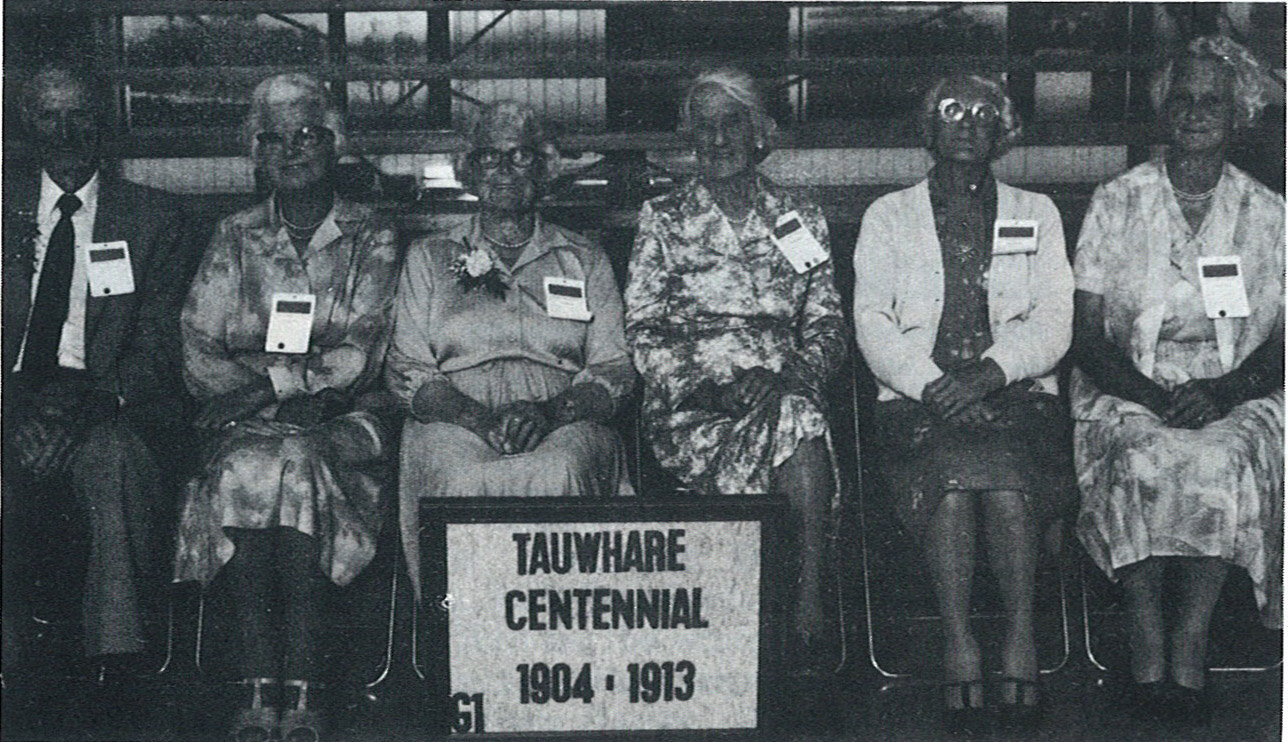
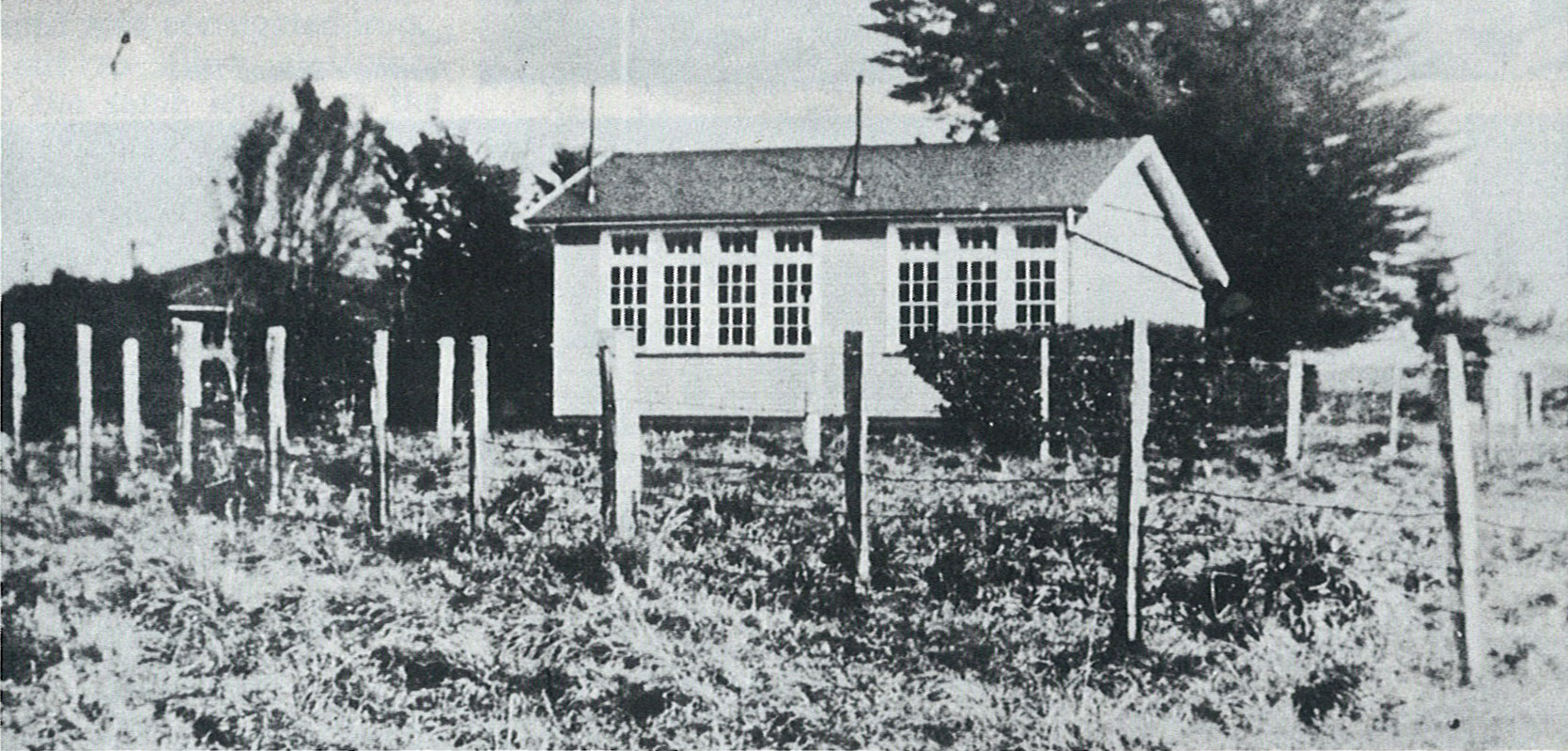
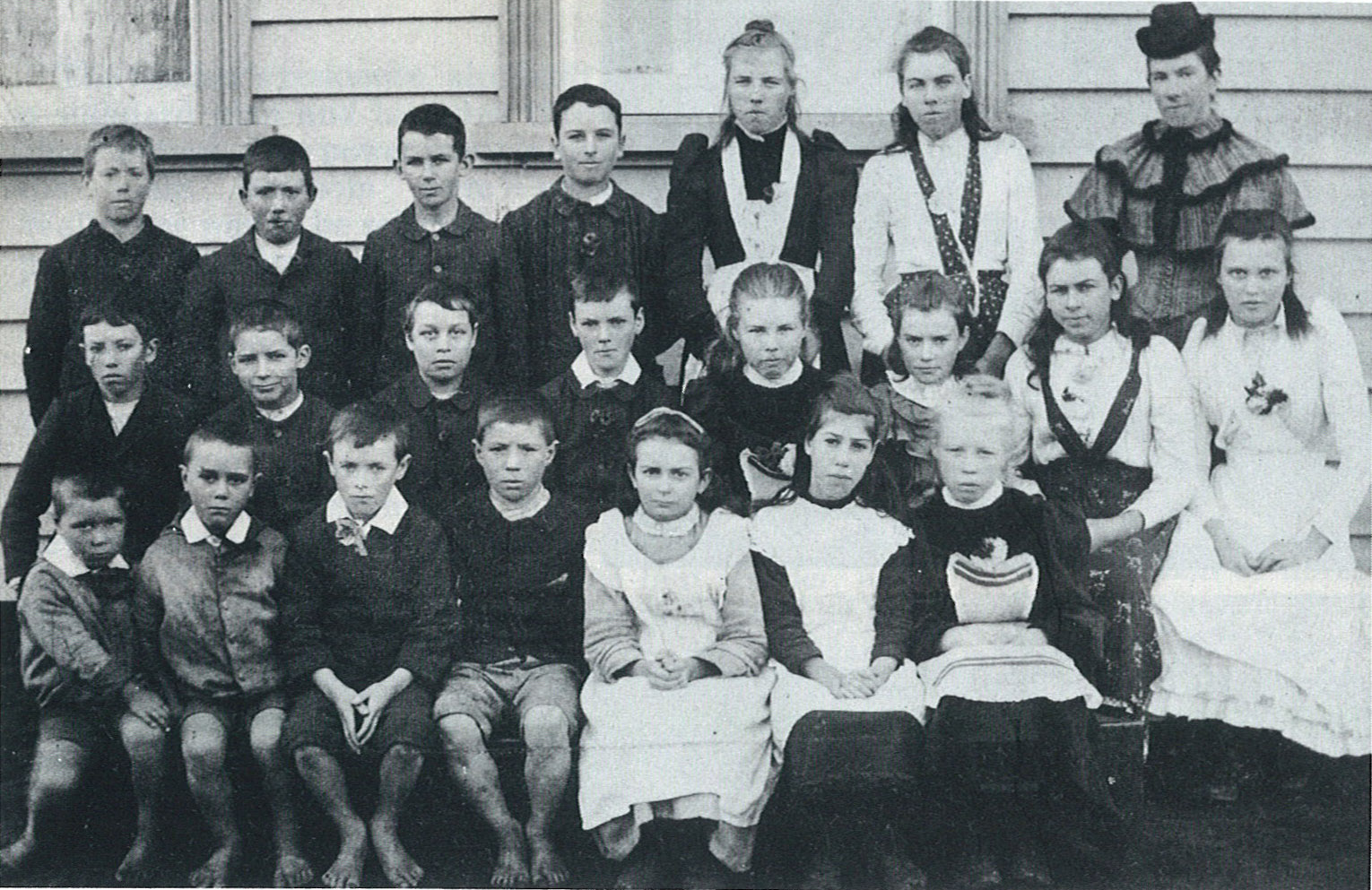

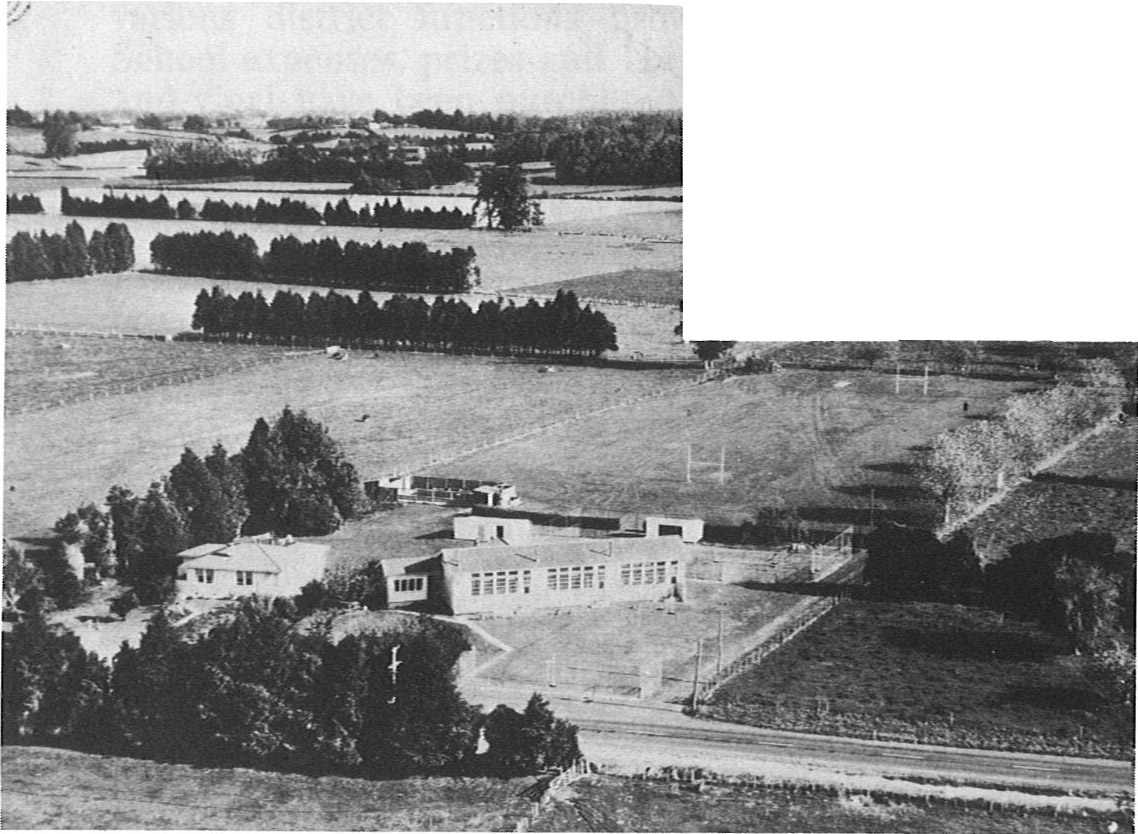
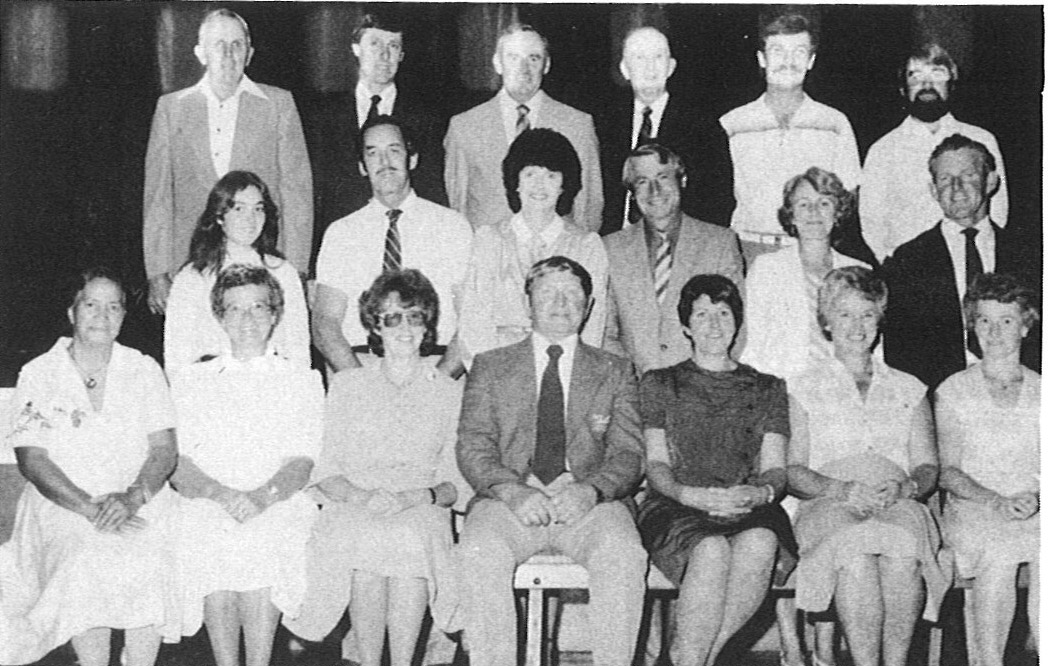
Back row left to right -
W. Silvester, A. Walker, G. Dingle, R. Ferris, H. Davison, A. Hoskins.
Middle row - K. Gunn, R. Goodare, D. Pizzini, N. Woodcock, P. Robertson, I. Spencer.
Front row - M. Hapi, V. Smith, C. Woodcock, I. Pizzini, J. Hoult, J. Silvester, N. Berry.
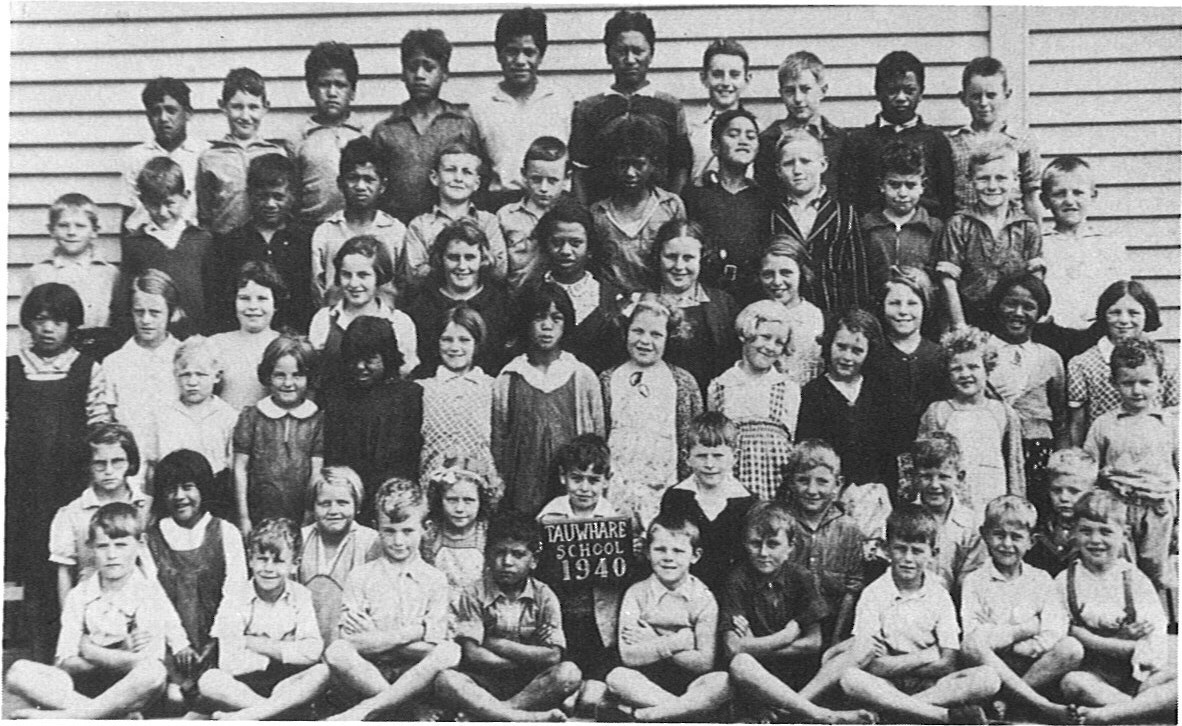
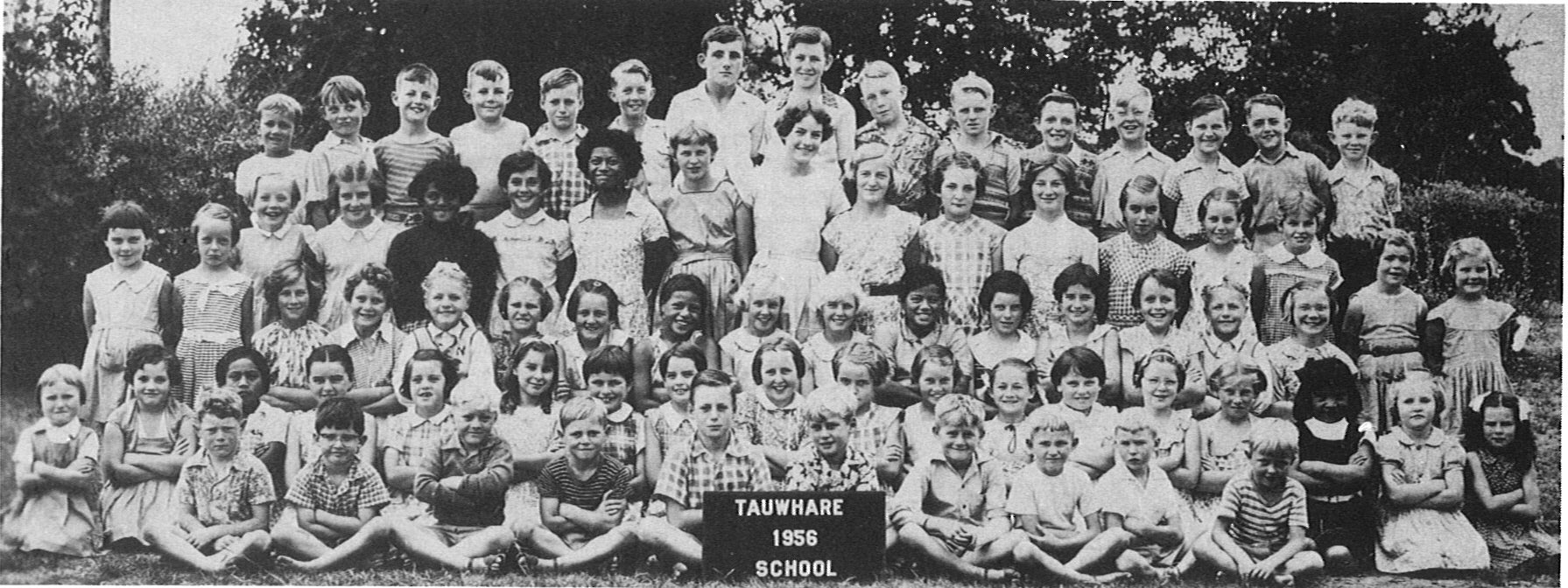
The teacher's residence, also built by SPND Ltd., was a standard plan and included three bedrooms and an electric stove. One power point in the kitchen and one in the main bedroom were considered sufficient. Wallpaper was to be selected at no more than 45 cents per roll. The first occupants of this new residence were Mr and Mrs Charles Day and family.
The old School was sold for removal, to Mr G. Brown for $150.00. Mr Brown took it just up the road and built a house now Mr T. Fleming's.
About 200 people, including 13 first day pupils, attended a jubilee reunion to mark the opening of the new buildings which cost approximately $8,000.00. The Rev. C. W. Clark, who had been the first teacher, was present. The Opening Ceremony was performed by Mr R. Coulter, M.P. for Waikato. Mr A. N. Macky represented the Education Board. Mrs Andrew Ramsay, (nee Aubin) a former teacher, unveiled a tablet in memory of ex- pupils who died in World War One.
Roll numbers, which had been fluctuating between 43 and 58, began to climb steadily until they reached 84 in 1949. Once again the School was too small. A shortage of trained teachers prevented the appointment of a third teacher, but Mrs M. Connell, the wife of the head teacher, stepped into the breach and taught Standards 1 and 2 in a shelter shed, from September 1949 to June 1951 when a newly added third classroom was ready for occupation.
Mr J. R. McKinnon of Hamilton built the extensions which cost $5,114.00. As corrugated iron was scarce, the new roof area was fibrolite. Totara, matai and rimu timbers were used. The floors were sanded and waxed. A new staffroom was built alongside the main entrance. Classroom 2, which had been the smaller, was extended to 26 feet (7.9 metres) and the new classroom 3 was the same size. Classroom 1 was now the smallest at 20 feet long (6.1 metres). The corridor was extended to allow entry to the new classroom and an additional exit door was provided at the end of the corridor. One electric power point was installed in each classroom and the staffroom, and two additional handbasins in the corridor. The whole School was painted inside and out.
Numbers continued to rise, reaching 96 in 1954. The opening of Ngati Haua School in 1955 relieved the pressure temporarily, but by 1958 there were 100 names on the roll. During the early 1960's numbers remained in the nineties, and the Committee began pressing for further enlargements. The small classroom Number 1 could not accommodate enough desks for Standards 1, 2 and 3, so Mr Witten had Standards 3 and 4 and Forms 1 and 2 jammed together in Room 2.
Finally in 1966 the Education Board approved extensions. Miss Maloy, with Standards 1 and 2, moved into the Sunday School Hall for the winter term, while F. R. Murphy Ltd., builders, worked around Mr Witten and Miss Brunskill and their classes. The timber used this time was rimu, with matai flooring. The fibrolite roofing was removed and replaced with corrugated iron. The staffroom was moved out to allow classroom Number 1 to be extended to the same length as the others. A steel lattice beam was installed along the south west of all three classrooms to support the roof when the wall was removed. The corridor became part of the classrooms, increasing them all in width to 28 feet (8.5 metres). Sink benches and cupboards were installed in the classrooms using the plumbing from the old handbasins. A new corridor was added with a door at the western end and storage cupboards and staff cloakroom at the eastern end. New toilet blocks were built at the rear with covered access to the corridor. Direct access doors facing the road, were cut in each classroom. Extra shelving was provided in each classroom. Committee, staff, parents and pupils were delighted with the results. The total cost was $14,253.00.
During 1968, after consultation with Education Board officials and much discussion among themselves, parents agreed that Forms 1 and 2 should go to Peachgrove Intermediate School from the beginning of 1969. So a new era began at Tauwhare School, with smaller classes in large airy classrooms, allowing space for artwork and other activities. For a short period in 1978 the School dropped to two teachers, and Room 1 became an art and music and film room. However, numbers quickly increased again and within a few months it was once again a normal classroom.
The most recent addition to the buildings is the library. During 1979, parents became enthusiastic about the provision of library and withdrawal space separate from the classrooms. Local fundraising began and when Education Board approval was given the library was built by extending the corridor and taking in part of Room 3. The total cost was $4,500.00. The Education Board provided carpet and made grants of $2,000.00 towards building costs and $250.00 towards shelving. Of the rest, almost $1,800.00 was raised locally by the P.T.A. and School Committee. When the library was opened in November 1980, parents donated $318.00 worth of new books, and the children $269.00 which they had earned by baking cakes for auction.
The School remains a three teacher School with roll numbers hovering around 50. So it enters its second century with plenty of space, and facilities which should be adequate for some years to come.
Opening Day
Tauwhare School opened on the 3rd November 1884, when the following 29 pupils were enrolled from 11 families.
1. George P. Russell
2. Edw. J. Williamson
3. James Shaw
4. Robert J. Williamson
5. W. James Richardson
6. John Shaw
7. William Walker
8. J. Henry Dodd (Geof)
9. George Dodd
10. Sutherland Shaw
11. George Williamson
12. E. Maurice Diprose
13. William Grigsby
14. Stephen Edw. Grigsby
15. James Took
16. Annie Took
17. Sophia Took
18. Lina M. Dodd
19. Bella Hansford
20. Mar. S. Russell
21. Agnes S. Russell
22. Alice M. Diprose
23. Letisha Ann Diprose
24. Juliet Shaw (Janet)
25. Agnes Shaw
26. Mildred Rockell
27. M. Elizabeth Grigsby
28. Margaret Richardson
29. Ellen Eliz. Williamson
Maurice Diprose (b. 29/11/79) was the youngest - almost five years.
Mar. S. Russell (b. 20/01/69) was the oldst- 15 years. Young James Took was entered after the other boys at No. 15 but the entry date was then changed to 6/8/85 to coincide with his 5th birthday. Perhaps he was sent home on the first day, to return nine months later on his birthday. Perhaps he was allowed to stay but could not be registered officially until five years old.
The teacher was Mr C. W. Clark. His salary was $160.00 per year. Before the end of 1884 two more pupils were enrolled- Richard J. Dodd and Te Raru Metawa.
The First Forty Years
Approximately half the numbers of pupils who left the School, gave another district as their destination. One quarter gave their destination as home or home work, and the other quarter had blank spaces beside their names, or simply the word 'left'. Probably some of these stayed at home. Their ages indicate this.
In the first fifteen years many left from Standard 3 upwards and from 12 years old. Some who left to help at home were re-admitted after a few months, perhaps when their help on the farm or in the house was no longer required. Some were re-admitted after spendmg oe or two months at another School, and others were admitted to Tauwhare for only one or two months. Perhaps these were sent to relatives while mother had a new baby.
Around the turn of the century, the pattern began to change. All ofthose leaving school were at least 13 years old, and many stayed until 15 years old or until they had completed either the Standard 5 or the Standard 6 year.
In those days very few pupils left Tauwhare School to attend High School. The first was Frank Browning in 1903. He was followed by Helen Shaw in 1917, and Kenneth Shaw and Fred Clarkin in 1921.
Only two pupils died during this period. The destination of Nehi Pa in 1911 was given as Heaven. Louisa Shaw is recorded in 1907 as being "removed by death". Perhaps we can infer that school age children of those days were healthy and not accident prone.
Twins
Nineteen sets of twins have been admitted to the school since 1884.
1. 03/11/84 Alice and Letitia Diprose (First Day pupils)
2. 20/04/03 Richard and Samuel Keatinge
3. 28/09/03 Henry and Arthur Field
4. 28/08/71 Pearl and Ruby Aukett
5. 04/09/76 Nora and Georgina Patterson
6. 08/03/21 Roy and Joyce Twyman
7. 06/02/33 Brenda and Shirley Carmont
8. 03/02/36 Gerald and Brian Mancktelow
9. 10/06/40 Barbara and Heather Bennett
10. 18/10/42 Rex and Audrey Ollerenshaw
11. 02/06/50 Robin and Peter Hansen
12. 05/02/51 Elsa and Nancy Badger
13. 11/02/52 Christopher and Carol Sleep
14. 08/09/52 Clarice and Ngaire Mickell
15. 06/09/54 Janet and John Mellish
16. 05/06/62 Jo-Ann and Jan-Eine Claridge
17. 06/03/72 Beverley and Peter Croft
18. 28/05/73 Lynette and John Bassett
19. 09/04/84 Karen and Lisa Fraser
Attendance
The nineteenth century attendance registers are lost, but twentieth century attendances have been very good, especially in the senior room. The junior pupils suffered more from sickness. In the first term of 1931, eleven juniors went down with chicken pox within three weeks. In 1938 a measles epidemic struck the junior room in term two. Twenty children succumbed all at once, quickly followed by three more, and another nine within three weeks. The third term was always a bad one for sickness in the junior room.
An unnamed epidemic of sickness hit the school in 1945 and bad influenza in 1954, 1970, 1973, 1979.
On September 2nd, 1933, bad weather kept nineteen juniors at home. There were no buses and few cars in those days.
Many children, especially in the senior room, had excellent attendances, missing only one or two days each year. Some achieved a perfect score - full attendance for a whole year.
1932 Daniel de Lucca
1933 Zoe Jeffreys
1934 Zoe Jeffreys, James Neil, Colin Reese
1936 Mary Te Kata, who, after an excellent record of attendance throughout her schooling, finally achieved the perfect score in her Form 2 year.
1941 Selwyn Pope, Zoe Runciman
1942 Alex and Cathie Woods
1943 Lindsay Potts
1944 Alex Woods
1955 Dianne and Kevin Shaw, Dorothy and Nelson Lawrence
1956 Russell Richardson, Dianne Shaw, Dorothy Lawrence
1958 Dianne Shaw, Paul O'Neill
1959 John Mellish, Brenda Nixon
1960 Marie Mellish
1962 Allan McDonald
1963 Maureen
1964-71 Attendance Registers Missing
1972 Allan Coxon, Gayle Brockway, Christopher McKay, Deborah Jamieson, Barry Inglis, Michael Watts, Sharon Inglis, Alice Brockway, Nancy Watts
1973 Peter Watts, Eileen Berry, Robyn O'Neil, Simon Noble, Michael Watts, Alice Brockway, Tania Preston, Robyn Smith, Nancy Watts, Paula Coxon
1974 Elizabeth Muir, Trevor Browning, Tania Preston
1975 Wayne Brown, Alice Brockway, Tom Dingle, Marten Loomans
1976 Paula Coxon, Jan McClennan, Darrin Edwards, Robert McMullen, April Teriaki, Mathew Auld, Paul van den Bernd, Scott McHardie, Shane Edwards, Robin Hapi, Colin Berry, Jane Auld
1977 Peter Tollan, April Teriaki, Paul van den Bernd, Colin Berry, Nicola McLeary, Judy Norris
1978 Mathew Auld, Scott McHardie, William Muir, Bridget Dingle
1979 Gavin Coxon, William Muir, Diane Norris, Colin Berry
1980 Colin Berry, David Kennedy
1981 Gina de Nicolo
1982 Frances Smythe
1983 Justyn Smythe, Robert Verner
Closures
Most Closures have been for only one day. In the 1930's later 1940's (after World War Two) and the 1950's' this was usually to allow families to attend Agricultural and Pastoral Shows at Hamilton and Cambridge or Morrinsville. In many years school closed for a school picnic and inter-school sports.
Election days in 1931, 1935, 1946, 1949 caused closure while the school became a polling booth.
The head teacher, Miss M. Mackay, died of pneumonia in 1933 and the school closed for a day in respect. This also applied on the death of Prime Minister Savage in 1940.
Special holidays have been granted when the Waikato has been visited by Royalty, Governors General, and other important persons.
Nation-wide polio epidemics closed the school early, at the end of 1936 and again in 1947. On the second occasion school did not re-open untill April, 1948.
It has been suggested that the school closed for a few months in 1896 because roll numbers dropped,, and that Tauwhare children rode to Newstead. Neither the Tauwhare register, nor the lists of Newstead puplls record this. Two children from Tauwhare transferred to Newstead but they came from there originally. There was a change of teacher during 1896 and roll numbers were low. It seems likely that the school was without a teacher for a period. Older children left school, never to return. Younger children stayed at home, and returned to school in late 1896 and early 1897.
Several Generations
About 2,200 children have been enrolled at the school. Numbers are not exact because some children have been withdrawn and later re-admitted a second or even a third time. Many families moved away and none of the original surnames appears on the roll today. However several families have had three or four generations attend for a part of their primary schooling.
The descendants of one first day pupil, Margaret Richardson, have lived in the district through out the 100 years and all attended Tauwhare School. Margaret Richardson became Mrs Ferris and her four chlldren were all pupils. Norman and Bob Ferris still live on he family farm. Their sister Esme' (enrolled 1914) mamed Walter Pope (enrolled 1909). Their children all attended. One son, Noel, still lives in the district, and his sons, Jason and Marc, are the fourth generation to pass through the school.
The daughters of Ernie Pope (enrolled 1910) attended the school and their children in turn. Many descendants of the Shw family have attended. These include the children of James Shaw and his brother Charles who arrived in 1880 and 1881. The Carmont families descended from Winifred Shaw, a daughter of Charles, Descendants of McGregor Shaw, a son of Charles, also attended. James Edward Shaw was a son of David Shaw, eldest child of the original James. James Edward and his wife Ruby (nee' Pope) both attended, as did four of their children and three grandchildren.
The oldest ex-pupils still living in the district today are Norman Ferris (enrolled 1916), Bob Ferris (1917), Win Morrison (nee' Nicholls 1925), Mary Hapi (nee' Te Kata 1928) and Glenalva McKenzie (nee' Goodare 1930).
Staff
Sole Teachers
1884-87 Mr C. W. Clark
1887-88 Mr T. F. Newcombe
1888-92 Mr J. Graham
1892-95 Miss E. E. Biggs
1895-96 Miss A. B. Krippner
1896-1903 Miss A. G. Kerr
1903-11 Miss L. A. Aubin
Head Teachers
1911-28 Miss E. Wilson
1928 Mr W. Black (R)
1928-30 Mr R. C. Barker
1931-33 Miss M. G. MacKay
1933-35 Mr G. J. Grant
1936-48 Mr C. Day
1949-55 Mr R. L. Connell
1955-68 Mr F. L. Witten
1969-78 Mr R. G. Fowler
1978-83 Mr G. Allen
1983 Miss B. Robertson (R)
1983- Mr A. Hoskins
Assistant Teachers
1911-18 Miss Pickering
1919-20 Miss Spargo
1920-22 Miss D. Taylor
1923-24 Miss Moore
1924-27 Miss B. James
1928 Miss L. Hunt
1929-40 Miss I. J. Phillips
1940-42 Mrs M. H. Watson
1943-45 Miss H. P. Hirst
1946 Miss A. M. Rive
1947-48 Miss E. G. Tiddy
1949-50 Miss M. G. Armour
1949-51 Mrs M. Connell (R)
1951-53 Miss Z. Anderson
1952-56 Miss L. A. Caldwell
1954 Miss L. M. Connell
1954-56 Miss M. TeH. Riddell
1957-58 Miss E. M Sullivan
1957-59 Miss L. M. Willis
1959 Mr G. Richards (R)
1959-61 Miss A. J. Lambert
1960-61 Miss D. M. Bowler
1962-63 Miss G. R. Amesbury
1962-64 Miss R. Campbell
1964 Miss B. A. Bint
1964-65 Miss J. A. Dawson
1965-66 Miss B. M. Brunskill
1966-67 Miss J. M. Maloy
1967-69 Mrs K. Sullivan
1968 Miss R. Armstrong
1969-73 Mrs S. McKay
1969 Mrs A. Johns (R)
1970 Mrs J. C. Thompson
1970-73 Mrs E. Holloway
1974 Mrs J. Davie Martin
1974 Miss D. A. Hall
1974-76 Mr J. Madsen
1975-77 Mrs J. Batty
1976-79 Mrs M. Atkinson
1977 Mrs A. Dyer
1978 Mrs M. Lang (R)
1979-80 Miss L. Bendiksen
1979 Mrs M. Lang (R)
1980- Mrs M. Whyman
1980- Mrs A. Currie
(R = Relieving)
Relleving Teachers:
Local ex-teachers have willingly taken charge of classes while permanent teachers have been absent through sickness, bereavement, exammations or in service courses. During the last fifteen years these have been Mrs M. Lang, Mrs B. McClennan, Mrs S. Jamieson, Mrs A. Spencer and Mrs J. Allen.
Clerical Assistants:
Up until 1975 the head-teacher had to do all the clerical work after school. From 1975 the followmg have worked at the school: Mrs B. Fowler, Mrs L. Gunn, Mrs A. Spencer and Miss J. Young.
Students:
During 1970 student-teachers from Hamilton Teachers' College began coming to the school to observe lessons and to practise teaching. The first student teacher was herself, an ex-pupil, Miss Jill McHardie.
Inspectors' Reports
Inspectors remarked not only on the progress of the children and the efficiency of the teachers, but also on grounds and building, their tidiness and cleanliness.
1929. "Two teachers are working under great difficulties in an old building. Accommodation is very cramped, a semi-partition screen having been erected. Repairs are required in the boys' outbuildings which were overturned in a recent gale. The sanitary arrangements are unhygienic".
1931. "Accommodation is not convenient, a partition half way to the roof divides the room but not the sounds".
1933. "We would like to place on record our appreciation of the fine work done in this school by the late Miss May MacKay. Defective spouting calls for attention. One room is shared by two teachers, with a low partition".
1934. "Two teachers occupy one room with a low partition. Dry sweeping is condemned. Damp sawdust or oil should be used".
1935. "An old type school, crowded and dingy, provides poor conditions for pupils and teachers. Thorough cleaning is difficult".
1936. "In this old type schoolroom the accommodation is insufficient and teaching conditions are most trying. The grounds, however, are well kept".
1937. "During the year a new school building was erected and the teaching conditions are now greatly improved. The corridor might present a neater appearance".
1938. "Grounds are being improved to conform with the orientation of the new school".
1939. "Teacher's table not a model of smartness. Music is distinctly pleasing".
1940. "The room was clean but there are possibilities in regard to tidiness and improvement of walls".
1942. "Buildings in good order, classrooms being bright and clean. A happy spirit of co-operation between home and school".
1943. "Classrooms are clean and orderly. Oiling of floors is recommended. Musical training is a commendable feature".
1945. "Improvements: Septic drainage installed. Tennis courts resurfaced. Swimming pool constructed, and piano purchase intended with financial assistance given locally".
1949. "Buildings are clean but increasing numbers have rendered them inadequate. Pleasing interest by Committee".
1951. "Buildings are now adequate".
1954. "The Parent-Teacher Association is active".
1958. "Committee, parents and staff are con- gratulated on efforts to provide equipment and amenities".
1961. "Strong and enthusiastic support from School Committee, P.T.A. and community".
1964. "Committee support commended, also P.T.A.".
1967. "Remodelling of school building has increased classroom space and storage space and provided toilets linked to the building. Committee and P.T.A. are commended".
School inspections are now much less frequent and building supervision is undertaken by Education Board Officers.
Achievement
The registers of examinations, progress and achievement contain interesting comments. Some teachers obviously set high standards and were disappointed when these were not achieved. Others were satisfied with the standards achieved. When staff changed it is obvious that teachers with particular talents or preferences set about improving or emphasizing those subjects.
In the 1920's Miss Wilson seemed to be having a difficult time with results described as 'very average' or 'generally poor'. A few achieved 100% in maths in 1923 and there were some good readers, but in 1924 she had to demote some children during the year and hold others back at the end of the year. The 1925 results were still average to below average and she noted that some children had been admitted at a late age and were in classes low for their age.
A new Head-Teacher noted in 1928 that a large group of bright young pupils in the primers all had consistent marks above 65% and 12 were promoted to Standard 1. However, 1929 saw six ofthose back in the primers again - no social promotion in those days. In 1936-37 better results were being achieved in the senior classes. These children would have been the bright young primers of 1928.
During the 1940's progress and achievement seemed satisfactory with children promoted regularly. A roll imbalance appeared in 1943 and lasted for several years with very large numbers of younger children. Standard 2 had to go into the senior room and Form 2 pupils were giving assistance by hearing some of the infants oral reading. The polio epidemic of 1947-48 and the consequent late opening of school in 1948 showed up in slower progress that year. The cramped and unsatisfactory conditions also hampered progress 1949-51.
When the 1960's were reached, once again disappointment at standards was expressed. Television and less reading at home were blamed for lower standards of comprehension and written expression.
School Committee
The records are incomplete but the following are known to have served on the School Committee:
A. C. Massey M. Morrison
F. Windsor I. Davison
Alex Ramsay Mrs M. Lang
T. P. Coles F. B. Lamb
L. Skinner R. Noice
P. Te Kata J. Gommans
H. Cathro A. Silvester
D. Fell Mrs J. Carmont
J. Spencer Mrs P. Nichols
T. Parker W. Silvester
W. Pope G. Dingle
McG. Shaw B. Brockway
M. Carter B. Berry
K. Lawrence Mrs B. McClennan
F. Hansen I. Spencer
R. Richardson B. Auld
T. D. M. Hoult N. Woodcock
K. Lovelock B. Southcome
A. O'Neill R. Hunter
M. Stringfield Mrs C. Hapi
P. Robinson D. Fraser
C. Badger M. Kennedy
R. Nicholls I. Paterson
B. Andrew R. Franks
Len Skinner has been the longest serving member recorded -13 years as Secretary 1940-53. F. B. Lamb, W. Silvester and G. Dingle all served 10 years. F. L. Witen, Head Teacher, served as Secretary 1957-65.
Running the School
In 1963 the South Auckland Education Board took over school accounting. We still have the Tauwhare School Account Book for 1906-1954 and it can tell us quite a lot about running the school. The Education Board Grant for running costs was $20.00 in 1907 and by 1954 had risen to $264.00. Today it is $2,216.00 excluding cleaning.
Up until the 1930's cleaning and stationery were the two main items of expenditure. School cleaning cost $5.00 in 1906. By 1911 it had risen to $20.00 but included 'atending outhouses'. The 1954 cleaning costs were $166.00 and today's $3,120.00 per year. During World War II and for some years afterwards the children were sweeping the school, with another person employed to scrub the floors and clean windows in the holidays.
Stationery was the other main item of expenditure. Frequent purchases were 'rollends' (of newsprint) from Waikato Times.
For two years, 1910 and 1911, the Tauwhare Committee seemed to have oversight of Matangi School. Separate lists of receipts and expenditure were kept for both schools. Six months rental of the Matangi Hall in 1911 cost $39.00. The Matangi account was slightly overspent in 1910, but when the Matangi Committee took over in January 1912 a balance of $17.50 was paid over to them.
An exciting event must have been the installation of electricity in June 1936. This cost $9.30 and was partly covered by a special Education Board Grant of $6.00. Two heaters were bought and the first electricity bill in September 1936 was $1.68. Later bills were much smaller. This use of electric heaters must have been a temporary measure until the new school was built, with pot bellied stoves for heating.
A telephone was installed in 1937 and a toll call to the Education Board Office in Auckland cost 17 cents.
The 1943 School Committee suggested that the Education Board build a Maori School or provide a larger bus. This matter was raised again in 1951 when the school was over-crowded and the bus over-loaded. The re-organisation of Ray Richardson's bus routes to include Goodwood School, gave some relief until Ngati Haua School opened in 1955. The possibility of secondary school pupils going to Cambridge High School was raised in 1944 and again in 1966. This matter was finally resolved in 1968 when parents approved Intermediate and Secondary schooling in Hamilton.
The building of the swimming pool in 1945, was a major undertaking. The construction was undertaken by Mr W. Goodare. Costs came to $680.00. The Education Board gave a special grant of $305.00 and voluntary contributions made up the rest.
Once again in 1951 local contributors gave $154.00 towards a piano for the school. The Education Board added $144.00 and the purchase was made. The P.T.A. took over the fund-raising task from then on. In 1952 they raised $202.30. This was subsidised dollar for dollar by the Education Board and a Bell and Howell Film-projector and jungle-gym were added to the school amenities. In that year also the Board made a special grant of $60.00 towards dressing-sheds. The P.T.A. donated $57.25 towards this project and a concert raised $38.55. New dressing-sheds were built in 1972. The sale of baths keys began in the 1970-71 season and continues to help with running-costs of the pool.
Some Interesting Points from the Cash-Book
Sports goods such as basketballs and footballs couldn't be charged against school running expenses. These were disallowed by the Auditor. Other payments were sometimes disallowed if no receipt or voucher was submitted. In 1952 the Committee did not fully spend the wages grant for cleaning and lawn mowing, and the Board demanded a refund.
The Country Library Service was first mentioned in 1945, when expenses were $2.40. It is not made clear if this was for books lost or for services received. A separate item was $4.20 for N.Z.Railways for the return of the library books. They must have come from Auckland in those days.
In 1906 it cost 45 cents to have some bees removed from the School. By 1933 the charge for bee removal was 75 cents. Five hundred bricks to line a sixteen foot well, cost $2.50 in 1906.
Repairs were often unspecified in the Account Book but a 1910 entry shows window "pains" (sic) were replaced at a cost of 70 cents.
Parent Teacher Assodation
This began in 1950. Hard working Committees have worked behind the scenes to help the School and in most years have organised several general meetings. These have been of three types. Firstly, the staff or visiting experts spoke or showed films on aspects of child development and education, e.g. methods of teaching various subjects, choosing childrens books, equipment and teaching aids, school administration. Series of meetings were also held to discuss educational development, new maths, on the way to reading, and the Johnson Report on Education.
The second type of general meetings has included speakers on topics of general interest to adults and parents, e.g. Civil Defence, Crime Prevention, Alcohol and Drug Addiction, Road Safety, Guidance Counselling.
Social functions are the third type of gathering. These have included a progressive dinner, film evenings, travel talks and social evenings for adults, and family barbecues and family games evenings to include the children.
The Tauwhare P.T.A. has always been active in fund raising to provide amenities for the School. Efforts have included bring and buy stalls at Calf Club and Sports Days, Card evenings (organised by Mr Cridge in the 1960's and early 1970's), Housie, Bottle Drives, Raffles, an Auction of machinery and household goods, collection and sale of newspapers, and a calf-rearing scheme. These efforts have provided a duplicator, sports gear, books, listening post, tiny tots swimming pool, refrigerator for the staff-room, indoor games for wet days, prizes for school leavers, a floor polisher and the adventure playground.
Parents have willingly given time to help the School. They manned stalls and acted as stewards at Calf Club days. They have been markers and recorders at sports days. They have organised drinks, ice-creams, lunches and suppers at picnics, concerts and fancy dress balls. They have attended working bees to cut firewood and maintain and improve grounds and buildings. They have washed football jerseys and school towels. They have made cocoa during the winter term. They have covered books and made and repaired equipment. They have provided transport for sporting fixtures and school outings.
Well done!
Boys and Girls Agricultural Club
From 1934 to about 1950, the School was visited regularly by Agricultural Instructors who made regular reports and suggestions for the improvement and maintenance of school grounds and gardens and the teaching of nature study. They encouraged children's efforts in gardening and animal rearing.
Calf Club Day became a regular fixture on the School calendar. In the 1930's most children had to walk their animals to School for the Show, but after World War II, easier transport allowed them to travel further afield to group days and A & P Show Days. School was often closed on Show Days in earlier times but now only the prize winners take their animals forward to the Waikato Show. However, there is still keen competition to win the ribbons and cups at local level. The efforts of the children, their parents and the staff have often been commended by the School Inspectors, as well as the Instructors in Agriculture.
School Transport
In early days there were two modes of transport - on foot or horseback. A 1929 plan of the school grounds shows two horse paddocks. The smaller was on the south side, now the school house grounds and orchards. The larger was behind the school and was reached by a track on the northern side where the present drive leads to the football ground.
Sophie Cameron (nee Leask) remembers riding to school with a group from Eureka in 1923. On one occasion they raced their horses through the village and as a punishment were not allowed to ride through but had to dismount and walk through.
Alva McKenzie (nee Goodare) remembers the long walk down the Scotsman's Valley in the earlier 1930's and later the longer cycle ride to Matangi to catch the train to Secondary School in Hamilton.
The first bus to transport the Scotsman's Valley children was a canvas covered truck driven by Mr Mancel Carmont. Mr Ray Richardson, the local garage proprietor, took over in 1947. He had a green bus with long hard seats along both sides and down the centre. He took the Secondary School pupils out to the garage on Highway 26 to meet another bus, then on the way back delivered children to Matangi School. After that he went up the valley to collect the Tauwhare children.
In 1951 the route was re-organised to include Goodwood School. The bus then left Tauwhare at 7.40 a.m. to take out the Secondary School pupils as before. Children were taken to Matangi as before. Then the bus went to Goodwood via Ringers and Victoria Roads. It returned via Hill Road to Scotsman's Valley to pick up the Tauwhare children. In the afternoons Mr Richardson left his garage at 2.40 p.m. to begin the afternoon run at Goodwood School.
Mr Richardson found that bus driving was taking him away from his garage business too many hours a week, so in 1953 he sold the bus to Archie Perno. The routes remained the same until Ngati Haua School opened in 1955 when the Goodwood run was dropped and Ngati Haua included. Slight variations in routes and timetables have occurred, but the big changes have been improvements in both buses and roads. Secondary School pupils are now taken all the way to Hamilton on the one bus, and the Primary School bus serves Tauwhare and Ngati Haua Schools. The School bus service has been run for a number of years by Mr T. Pidduck and Cambridge Travel Lines.
The School Motto and Crest
In 1983 a competition was held to find a motto for the School. The winning entry 'Whakamaatau-Try' was suggested by Mrs Gillian Hansen. It was selected by staff of the Waikato Times because of its brevity, its encouragement to all, and its linking of the Maori and European elements of our society.
To go with the new motto, a School Crest was designed by the Centennial Jubilee Committee, incorporating suggestions from Mr D. Brell, Head Teacher, Ngati Haua School. The centrepiece of the crest is a Maori pattern representing the land. On either side of the land pattern are a crook representing sheepfarming and a cream can representing dairying, the mainstays of the district. Above the land pattern are a book and quill pen representing education and learning, and two running figures representing both physical recreation, and Maori and Pakeha moving forward together. A bronze cast of the crest has been mounted on the School wall and was officially unveiled at the Centenary Celebrations.
Centenary Celebrations 1984
Centenary Committee:
Chairman: Ivan Pizzini
Secretary: 1. Val Smith 2. Carole Woodcock
Treasurer: Judy Hoult
Committee: Nita Berry, Karen Gunn, Mary Hapi, Delia Pizzini, Philippa Robertson, Jocelyn Silvester, Hugh Davison, George Dingle, Bob Ferris, Dick Goodare, Warwick Silvester, Ian Spencer, Alan Walker, Neville Woodcock and the Head Teachers, Gavin Allen and Alan Hoskins.
Friday 6th April: A steady stream of people called at the School during the afternoon and evening to collect their nametags and look at the buildings and displays of photographs and mementoes.
Saturday 7th April: Official ceremonies were held outdoors in front of the School building. On the official dais were Mr Ivan Pizzini, Chairman of the Committee and Master of Ceremonies and Mrs Pizzini, Sir Douglas Carter, former Minister of Agriculture and High Commissioner in London, and Lady Carter; Mr Trevor Loomb, General Manager Hamilton Education Board, and Mrs Loomb; Mr Neville Woodcock, Chairman of the School Committee, and Mrs Carole Woodcock, Secretary of the Centenary Committee; Mr Alan Hoskins, Head Teacher and Mrs Hoskins; Mr Jack Hogan, District Senior Inspector Hamilton Education Board; Mr Simon Upton, M.P. for Waikato; Mr Colin Badger, Waikato County Councillor and Mrs Badger; Mrs Gillian Hansen, President of the Parent Teacher Association, and Mr Robin Hansen.
Mr Pizzini welcomed everyone to the celebrations. Flowers were presented to Lady Carter and sprays to the oldest ex-pupils present - Emma Dalbeth and Robert Werner. The School bell was rung by Mr Werner and Richard Verner, the youngest present pupil. Mr Loomb congratulated the School on reaching its centenary and wished it well in the future. Mr Hoskins and Mr Woodcock spoke briefly on the history of the School, and the support of parents.
Sir Douglas Carter said how pleasing it was to see both past and present pupils gathered together to celebrate. The School had been a centre for the district from earliest times when it was used not only for education but also for church services and social functions. Today the district is a part of New Zealand to be proud of. He had much pleasure in declaring the celebrations open.
A magnificent cake, made and iced by Alva McKenzie to represent the original school, was cut by the oldest female ex-pupil present, Mrs Emma Scott (nee Dalbeth) assisted by young Richard Verner.
Mr Hoskins explained the centennial project of a school motto and crest, and thanked the McInnes family who had presented a shield to be awarded annually to the pupil who best fulfils the school motto, Whakamaatau-Try. Sir Douglas Carter, Mr Simon Upton and Mr Ivan Pizzini then pulled the cord to unveil the bronze crest on the School wall.
Mr Pizzini thanked all people who had helped to prepare for the centenary and hoped all would enjoy the celebrations.
Mr R. Fowler, a former Head Teacher, called the roll of those who had registered from the years 1906-1934. Fifty two people responded. Mr G. Allen, also a former Head Teacher, called the roll by decades from 1934-1984, and the roll of ex-teachers who had registered, the oldest being Mrs B. Pegler (nee James) Assistant Teacher 1924-27.
In all, 550 people had registered for the centenary. Decade photographs were taken and lunch was served in a large marquee.
In the afternoon, two buses made two trips each around the district with George Dingle and Dick Goodare as comperes, pointing out farms and listing former owners.
The celebrations continued in the evening with a Dinner in the marquee and a Ball in the Tauwhare Hall, which was beautifully decorated with flowers and motifs in the School colours of black and gold, and with six hundred balloons. Two black and white sketches of the School in 1884 and 1984, by Wendy McHardie, were much admired. Mr Gordon Brunskill's band provided music for dancing, while a marquee attached, provided sitting out space for those preferring to talk about old times.
Sunday 8th April: A well-attended workship and thanksgiving service was held in the Tauwhare Hall. The Service was conducted by the Rev. Don Glenny of Hamilton, who spoke of looking both backwards and forwards. Mr L. Connell read Genesis 1: 24-31, Mr G. Allen Ecclesiastes 3: 1-9 and Mr B. Coles Proverbs 22: 1-6. Music before and during the Service was played by the Cambridge Band. Tea was served after the Service and Mr Colin Badger thanked the Committee for a wonderful weekend.
A video record of the celebrations was made.
I Remember 1923
We rode to School from Eureka. There was an empty house in an overgrown garden south of Lock's House (now George Langley's) and we easily persuaded ourselves it was haunted. There were sycamore trees in front of the School. Miss Wilson was the Head Teacher. She was an elegant lady with an air of authority, but she was alwaysJdnd and fair. I remember when it was discovered that a large pine tree by the horse paddock was almost cut through by some very small boys who had been busy chopping away at it in their lunch hours.
My lasting memory of Tauwhare will always be the sound of Frank Windsor's hammer on the anvil at the Blacksmith's Shop.
Sophie Cameron (nee Leask)
The Old Tauwhare School 1930's
Yes it was old when I was a child
Barefooted with clothes neatly mended,
The winters were never mild
Rain and sleet descended.
Frosts lifted the very soil
And sent the blood tingling in my veins
As the four weary miles I started to toil.
Envying those who held the reins
Of wild eyes horses that galloped and darted
Across the rutted road and back,
Steam billowing from the sack
Twixt horse and rider so daring.
And so to school I went -
Not really caring
What education meant.
But a lot of learning came
To those who liked to try
Some went on to fame
And some, so sad, to die
On battlefields afar
When war was raging there
Yes, they have crossed the bar,
But we are left to care
And remember the dear old school
With its pot bellied stove
Glowing red when days were cool.
I smell chalk upon the air
And I am there
I hear again the school bell ringing
And see the rows of bags
And coats so tightly clinging
To pegs with tags -
On each and every one a name,
Which did not help I fear
When home time came
My thoughts are good
Because childhood is so dear,
But the old school as it stood
Is a memory now I fear
My teachers are long gone
From that old place of learning
Changing life goes on
There's no time for yearning.
V. G. McKenzie (nee Goodare)
We Remember the 1940's
We remember on cold frosty mornings jumping, running and folk dancing on the tennis courts, to get warm.
We remember Carmont's school bus, known as the monkey bus.
We remember growing vegetables during the war years.
We remember learning how to run a meeting, and while the teacher was out of the room, a motion was passed to cut down the palm tree.
We remember going to Matangi School for swimming.
We remember standing in line with cocoa, sugar and milk in a cup, and eating it all before getting to the hot water.
Pat Montgomery (nee Wiggins)
Aileen Rayner (nee Wiggins)
Val Smith (nee Pope)
I Remember 1974
A red-faced teacher appeared handcuffed in front of the Head Teacher and School Inspector, after finding that the owner of the handcuffs did not have the key.
Judith Davie-Martin
